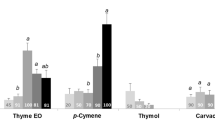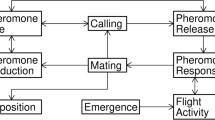Abstract
The effect of different concentrations of the sex pheromone (Z,E)-9,12-tetradecadien-1-ol acetate on the upwind anemotactic behavior of the malePlodia interpunctella (Hübner) was measured at 23 ± 1 ° C and 34 ± 1 ° C. The stimulus-response regression lines were analyzed by a new procedure that accounts both for control responses in the absence of pheromone and also for peak responses below 100% in the presence of concentrations considerably above the normal physiological levels. From the regression line for each temperature, the upwind anemotactic thresholds were calculated to be 1.34 × 106 molecules/cm3 at 23 ° C and 1.65 × 104 molecules/cm3 at 34 ° C, similar to other thresholds reported in the literature. Since departures from the two lines occurred at the highest concentrations tested, near 108 molecules/cm3, the upwind anemotactic behavior may change qualitatively above an altered-behavior threshold that is about two orders of magnitude higher than the upwind anemotactic threshold. The lower response at 23 ° C suggests that cool temperatures inhibit flight in response to pheromonal stimulation.
Similar content being viewed by others
References
Abbot, W.S. 1925. A method of computing the effectiveness of an insecticide.J. Econ. Entomol. 18:265–267.
Aylor, D.E., Parlange, J.-Y., andGranett, J. 1976. Turbulent dispersion of disparlure in the forest and male gypsy moth response.Environ. Entomol. 5:1026–1032.
Box, G.E.P., Hunter, W.G., andHunter, J.S. 1978. Statistics for Experimenters. John Wiley & Sons, New York.
Brownlee, R.G., andSilverstein, R.M. 1968. A micro-preparative gas chromatograph and a modified carbon skeleton determinator.Anal. Chem. 40:2077–2079.
Bursell, E. 1964. Environmental aspects: Temperature, pp. 284–317,in M. Rockstein (ed.). The Physiology of Insecta. Academic Press, New York.
Coster, J.E., Payne, T.L., Edson, L.J., andHart, E.R. 1978. Influences of weather on mass aggregation of southern pine beetles at attractive host trees.Southwest Entomol. 3:14–20.
Finney, D.J. 1971. Probit Analysis. Cambridge University Press, Cambridge.
Fuyama, Y. 1976. Behavioral genetics of olfactory responses inDrosophila I. Olfactometry and strain differences inDrosophila melanogaster.Behav. Genet. 6:407–420.
Gaston, L.K., Shorey, H.H., andSaario, C.A. 1971. Sex pheromones of noctuid moths. Rate of evaporation of a model compound ofTrichoplusia ni sex pheromone from different subtrates at various temperatures and its application to insect orientation.Ann. Entomol. Soc. Am. 64:381–384.
Hawkins, W.A. 1978. Effects of sex pheromone on locomotion in the male American cockroach,Periplaneta americana.J. Chem. Ecol. 4:149–160.
Kaissling, K.-E. 1971. Insect olfaction, pp. 351–431,in L.M. Beidler (ed.). Handbook of Sensory Physiology IV. Springer-Verlag, Berlin.
Kaissling, K.-E., andPriesner, E. 1970. Die Reichschwelle des Seidenspinners.Naturwissenschaften. 57:23–28.
Mankin, R.W., Vick, K.W., Mayer, M.S., Coffelt, J.A., andCallahan, P.S. 1980. Models for dispersal of vapors in open and confined spaces with application to sex pheromone trapping in a warehouse.J. Chem. Ecol. 6:929–950.
Marks, R.J. 1977. The influence of climatic factors on catches of the red bollwormDiparopsis castanea Hampson (Lepidoptera: Noctuidae) in sex pheromone traps.Bull. Entomol. Res. 67:243–248.
Mayer, M.S. 1973. Attraction studies of maleTrichoplusia ni (Lepidoptera: Noctuidae) with new combination of olfactometer and pheromone dispenser.Ann. Entomol. Soc. Am. 66:1191–1196.
Mayer, M.S., andMankin, R.W. 1980. In preparation.
Miller, J.R., andRoelofs, W.L. 1978. Sustained-flight tunnel for measuring insect responses to wind-borne sex pheromones.J. Chem. Ecol. 4:187–198.
Roelofs, W.L. 1978. Threshold hypothesis for pheromone perception.J. Chem. Ecol. 4:685–699.
Sanders, C.J., Wallace, D.R., andLucuik, G.S. 1978. Flight activity of female eastern spruce budworm (Lepidoptera: Tortricidae) at constant temperatures in the laboratory.Can. Entomol. 110:627–632.
Schneider, D., Block, B.C., Boeckh, J., andPriesner, E. 1967. Die Reaktion der männlichen Seidenspinner auf Bombykol und sein Isomeren: Elektroantennogramm und Verhalten.Z. Vergl. Physiol. 54:192–209.
Shapas, T.J., andBurkholder, W.E. 1978. Patterns of sex pheromone release from adult females and effects of air velocity and pheromone release rates on theoretical communication distances inTrogoderma glabrum.J. Chem. Ecol. 4:395–408.
Shorey, H.H. 1966. The biology ofTrichoplusia ni (Lepidoptera: Noctuidae). IV. Environmental control of mating.Ann. Entomol. Soc. Am. 59:502–506.
Shorey, H.H., Gaston, L.K., andSaario, C.A. 1967. Sex pheromone of noctuid moths XIV. Feasibility of behavioral control by disrupting pheromone communication in cabbage loopers.J. Econ. Entomol. 60:1541–1545.
Showers, W.B., Reed, G.L., andOloumi-Sadeghi, H. 1974. European corn borer: attraction of males to synthetic lure and to females of different strains.Environ. Entomol. 3:51–58.
Silhacek, D.L., andMiller, G.L. 1972. Growth and development of the Indian meal mothPlodia interpunctella (Lepidoptera: Phycitidae).Ann. Entomol. Soc. Am. 65:1084–1087.
Sower, L.L., Gaston, L.K., andShorey, H.H. 1971. Sex pheromones of noctuid moths. 26. Female release rate, male response threshold, and communication distance ofT. ni. Ann. Entomol. Soc. Am. 64:1448–1456.
Taylor, L.R. 1963. Analysis of the effects of temperature on insects in flight.J. Anim. Ecol. 32:99–117.
Vick, K.W., andSower, L.L. 1973. (Z,Z)-9,12-Tetradecadien-1-ol acetate: an inhibitor of the response to the sex pheromone ofPlodia interpunctella.J. Econ. Entomol. 66:1258–1260.
Vick, K.W., Coffelt, J.A., andSullivan, M.A. 1978. Disruption of pheromone communication in the Angoumois grain moth with synthetic pheromone.Environ. Entomol. 7:528–531.
Vick, K.W., Kvenberg, J., Coffelt, J.A., andSteward, C. 1979. Investigation of sex pheromone traps for simultaneous detection of Indian meal moths and Angoumois grain moths.J. Econ. Entomol. 72:245–249.
Wolf, W.W., Kishaba, A.N., Howland, A.F., andHenneberry, T.J. 1967. Sand as a carrier for synthetic sex pheromone of cabbage looper used to bait black light and carton traps.J. Econ. Entomol. 60:1182–1184.
Author information
Authors and Affiliations
Additional information
Mention of a commercial or proprietary product in this paper does not constitute an endorsement of that product by the USDA.
Rights and permissions
About this article
Cite this article
Mankin, R.W., Vick, K.W., Mayer, M.S. et al. Anemotactic response threshold of the Indian meal moth,Plodia interpunctella (Hübner) (Lepidoptera: Pyralidae), to its sex pheromone. J Chem Ecol 6, 919–928 (1980). https://doi.org/10.1007/BF00990476
Received:
Revised:
Issue Date:
DOI: https://doi.org/10.1007/BF00990476




